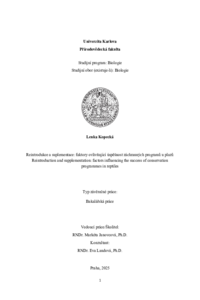Reintrodukce a suplementace: faktory ovlivňující úspěšnost záchhranných programů u plazů
Reintroduction and supplementation: factors influencing the success of conservation programmes in reptiles
bachelor thesis (DEFENDED)

View/
Permanent link
http://hdl.handle.net/20.500.11956/199373Identifiers
Study Information System: 272976
Collections
- Kvalifikační práce [20869]
Author
Advisor
Consultant
Landová, Eva
Referee
Chmelař, Jan
Faculty / Institute
Faculty of Science
Discipline
Biology
Department
Department of Zoology
Date of defense
3. 6. 2025
Publisher
Univerzita Karlova, Přírodovědecká fakultaLanguage
Czech
Grade
Very good
Keywords (Czech)
reintrodukce, suplementace, krokodýli, želvy, ještěři, hadiKeywords (English)
reintroduction, suplementation, crocodiles, turtles, lizards, snakesCílem této bakalářské práce je zanalyzovat faktory, které mají vliv na úspěšnost reintrodukčních a suplementačních programů u plazů. Na základě rešerše výročních zpráv IUCN a odborných článků bylo zaznamenáno 95 záchranných programů provedených u krokodýlů, želv, hadů a ještěrů. Mezi hlavní faktory, které byly zaznamenávány patří například původ jedinců (z volné přírody či ze zajetí), způsob vypouštění (hard release nebo soft release metoda), mortalita a úspěšnost rozmnožování. Pomocí těchto informací o záchranných programech byly identifikovány obecné i skupinově specifické faktory ovlivňující úspěšnost. Zároveň bylo zaznamenáváno i geografické rozložení a taxonomické zastoupení druhů. Porovnáním výsledků záchranných programů s jinými skupinami obratlovců (šelmy, ptáci, primáti a kopytníci) bylo zjištěno, že i když plazi vykazují vysokou míru úspěšnosti, záchranné programy zaměřující se právě na plazy musí čelit výzvám jako je například vysoká predace, nízká reprodukční rychlost a častá migrace.
The aim of this bachelor thesis is to analyse the factors that influence the success of reintroduction and supplementation programmes in reptiles. Based on a search of IUCN annual reports and peer-reviewed articles, 95 rescue programs conducted for crocodiles, turtles, snakes and lizards were recorded. The main factors that were recorded include the origin of the individuals (wild or captive), release method (hard release or soft release method), mortality and reproductive success. Using this information on rescue programs, general and group-specific factors affecting success rates were identified. Geographic distribution and taxonomic representation of species were also recorded. By comparing the results of rescue programs with other vertebrate groups (carnivores, birds, primates and ungulates), it was found that although reptiles have high success rates, rescue programs specifically targeting reptiles have to face challenges such as high predation, low reproductive rates and frequent migration.
